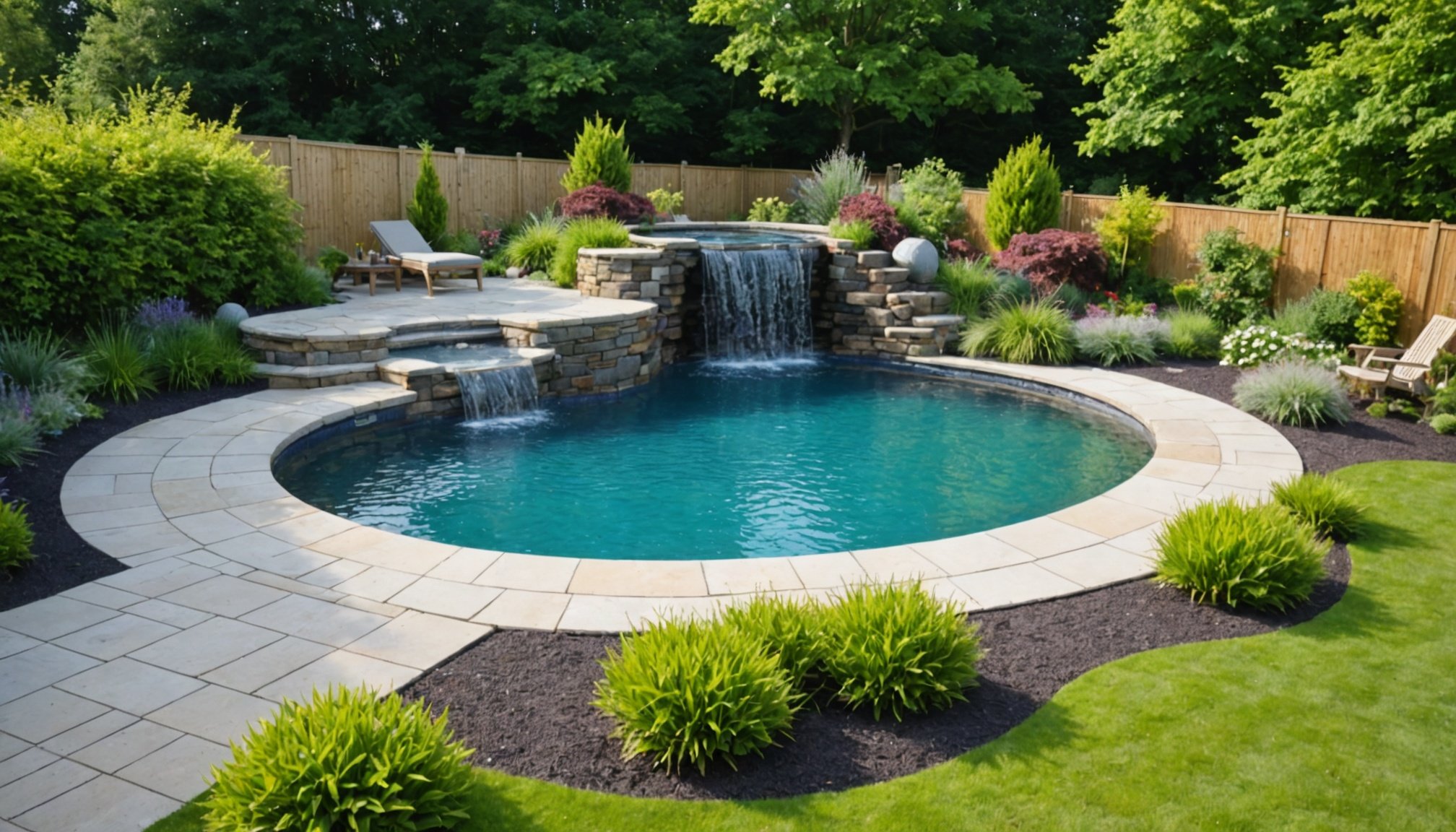Inspiration for Designing Your Pool and Waterfall Feature
When exploring pool design ideas, consider incorporating waterfall features to create a stunning visual effect. Waterfalls not only add a touch of elegance but also enhance the soundscape of your outdoor space, providing a tranquil environment. Selecting a design that complements your garden’s aesthetics is crucial to achieving a cohesive look.
Unique features can transform a typical garden into an extraordinary retreat. For example, UK gardens have embraced cascading waterfalls that drape over rock formations, offering both beauty and privacy. Such designs draw inspiration from natural landscapes, blending effortlessly with surrounding flora.
Also to read : Transform Your UK Home: Designing a Safe and Fun Pool Area for Kids
Elevate your garden’s appeal by focusing on aesthetic elements. Consider using native plants and ornamental grasses that harmonise with the water feature. Stone pathways or wooden decking can create elegant transitions between areas. Lighting, both functional and decorative, plays a vital role in highlighting these key features during the evening.
In the UK, various case studies showcase successful garden transformations involving pools and waterfalls. Homeowners have creatively used tiered designs and accentuating features, such as fountains, to innovate traditional layouts. These transformations illustrate how deliberate pooling and waterfall integration can significantly uplift garden aesthetics. Embrace creativity, and you will find myriad ways to customise your outdoor sanctuary.
Also to discover : Transform Your UK Home: Creative Tips for Designing a Stunning and Functional Pool Area
Practical Steps for Installation
Installing a pool with a waterfall feature requires careful planning and execution to ensure success. Following a structured approach, you can transform your garden into a captivating oasis.
Step 1: Planning & Location Selection
Identifying the optimal location in your garden is crucial. Consider sunlight, existing landscaping, and proximity to the house. Ensure there’s ample space for both the pool and waterfall to harmonise without overcrowding.
Step 2: Involving Professionals
Hiring experienced contractors is advisable to avoid technical mishaps. Professional support ensures structural integrity and aesthetic alignment with your garden vision. They can also assist with acquiring necessary permissions, streamlining the process.
Step 3: Construction Preparation
Before construction, verify that all required permissions comply with local regulations. This may involve submitting detailed plans to your local council for approval. Patience is key, as this step might take time but ensures your project is law-abiding.
Choosing high-quality materials suitable for UK weather enhances durability. Collaborating with suppliers knowledgeable about UK climates can aid in selecting appropriate resources, ensuring long-term resilience.
With each step, prioritising cohesion with your garden’s existing layout will lead to a seamless finish.
Landscaping Tips and Suitable Materials
Transforming your outdoor space into a captivating sanctuary requires thoughtful landscaping ideas and a keen eye for detail. When designing around pools and waterfalls, focus on creating harmony between the water elements and garden aesthetics.
Materials selection is pivotal. In the UK, opt for durable options such as natural stone or slate, which withstand the weather variances. These materials not only promise longevity but also blend seamlessly into the outdoor landscape, enhancing aesthetic appeal. Incorporating gravel pathways can lead visitors through your garden, adding charm and texture.
Selecting the right plants further amplifies your garden’s beauty. Choose plant selections that thrive in UK climates, such as lavender, ferns, or native grasses, to complement your water features. These plants require minimal upkeep while adding natural elegance to your outdoor space.
Consider adding raised beds or planters around water features for a lush, layered look. This not only frames your features but can also serve to introduce pops of colour through seasonal blooms.
Lastly, integrate lighting strategically to highlight features and ensure safe pathways. Spotlighting waterfalls can create stunning visual effects, particularly at night—perfect for entertaining and relaxing.
Maintenance Considerations for Pools and Waterfalls
To maintain your pools and waterfall features in top condition, a regular maintenance schedule is vital. Start with a weekly inspection of water levels and clarity. This helps quickly identify potential issues.
When managing pool maintenance, it’s essential to clean surfaces and check filtration systems regularly—ideally, every month. Routine checks prevent algae build-up and prolong filtration efficiency, key aspects for health and safety.
Waterfall upkeep demands attention to debris that clogs water flow. Ensure the pump functions efficiently by removing leaves and other obstructions weekly. An annual check-up with a professional technician can preempt significant wear or damage.
Using environment-safe treatments protects the UK ecosystem while ensuring the water remains crystal clear. Biodegradable algaecides and chlorine alternatives are recommended to maintain safe water chemistry.
Seasonal care is crucial to shield these features from weather fluctuations. During autumn, clear falling leaves promptly and switch to a winter-friendly pump if extreme cold is expected. Regular monitoring reduces freeze risks and maintains functionality during colder months.
Implementing these maintenance tips ensures your garden’s centerpiece remains a source of beauty and tranquility year-round. Proper care effectively balances aesthetics with functionality, integral elements for sustaining your outdoor oasis.
Budgeting for Your Garden Transformation
Transforming your garden with a pool installation and waterfall construction is an exciting endeavour, but it requires careful budget planning. Understanding the cost of installation helps in setting a realistic budget. Costs can vary widely depending on design complexity, materials, and labour.
When planning your project, consider expenses for excavation, pool lining, and waterfall features. High-quality materials and hiring skilled labour will influence overall costs but ensure durability and aesthetic integrity. Always allocate a portion of your budget for unexpected expenses such as delays or weather-related issues.
Financial considerations also include potential maintenance costs post-installation. To manage this, you can explore options like setting up a contingency fund to cover ongoing upkeep without financial strain.
Cost-saving strategies can significantly aid in budget management. Reuse existing materials where possible, and select native plants that require less water and maintenance. For financing, inquire about home improvement loans or consult with financial advisors to explore available options.
Budgeting effectively will not only facilitate a smoother implementation process but also allow you to enjoy your garden transformation without financial pressure. Prioritise your needs and allocate your resources wisely for maximum satisfaction.
Navigating Local Regulations and Climate Considerations
Before undertaking any pool installation or waterfall construction, it is vital to understand local regulations, particularly in the UK. These regulations ensure safety and environmental standards are met. Planning permissions may be required, depending on the scale and location of your project. Failure to comply can lead to legal challenges, disrupting your garden ambitions.
The UK’s diverse climate must also be considered during garden planning. Harsh weather can affect the longevity of materials and installations. Consider selecting weather-resistant materials for robust, enduring features. Materials like stone and slate are advantageous, providing resilience against rain and frost.
Climate impact extends to plant choices, with selections tailored to local conditions thriving best. Native plants that withstand fluctuating temperatures reduce maintenance burdens and blend harmoniously into the setting. They conserve water and contribute to sustainability efforts.
To navigate regulations effectively, consult with local councils and experienced professionals. Resources are available online and through local government offices to check compliance guidelines. Engaging experts familiar with local regulations ensures your garden transformation adheres to legal frameworks seamlessly, allowing you to focus on design and enjoyment safely.











